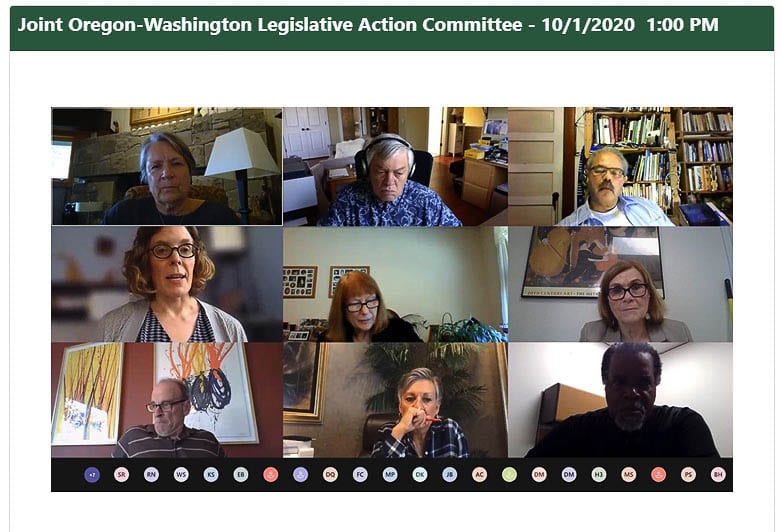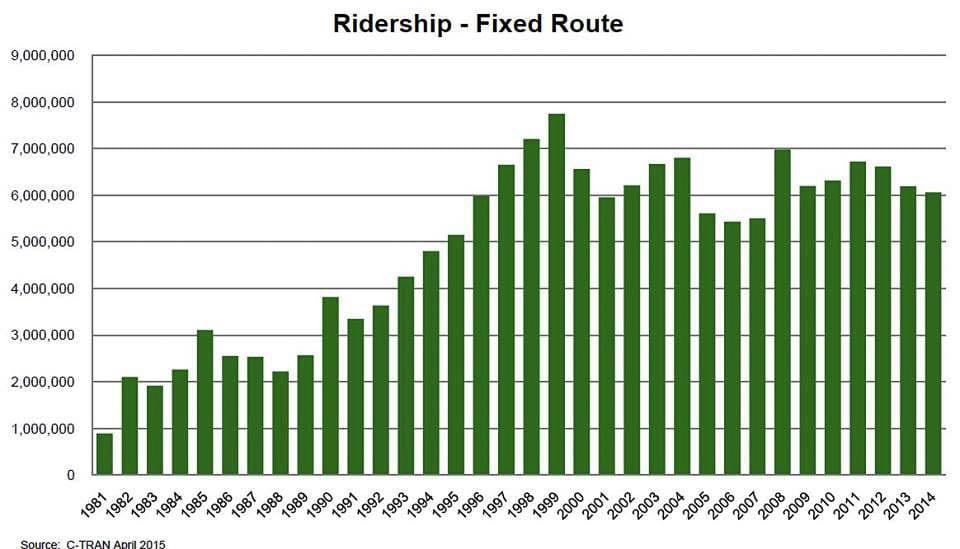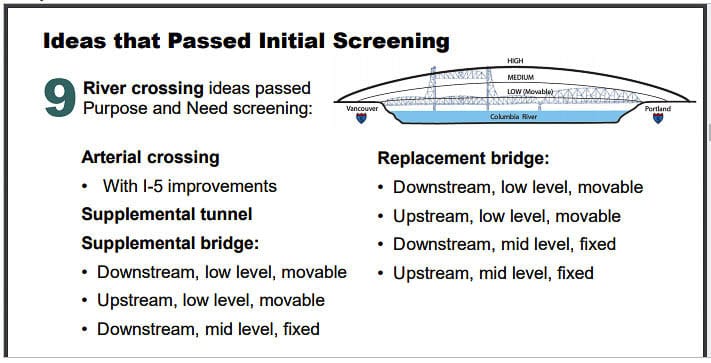Transit and bridge options reviewed from 2008 CRC process
One of the most hot-button issues for Southwest Washington residents over the past decade has been the Columbia River Crossing (CRC) project. The $3.5-billion project would have extended Portland’s MAX light rail into Vancouver, and would have proposed to establish tolls to pay for borrowed funds. An Oregon Supreme Court Justice labeled the project “a light rail project in search of a bridge.”
In 2013, the project failed to advance when the Washington legislature failed to approve $450 million in funding. Oregon made a brief “go it alone” effort, but that failed a year later.

Because both states spent $140 million federal transportation dollars on the effort ($200 million total), they must either resume construction of a bridge project or pay the funds back. Oregon used $93.3 million in federal highway money while Washington used $46.1 million, according to one news report.
In response, the Washington legislature allocated $35 million to fund two years of a replacement bridge project. Oregon allocated $9 million for the first year, according to this news report.
A 16-member committee of elected legislators from Oregon and Washington is overseeing the renewed efforts. They began meeting in late 2019.
The Bi-State Bridge Committee held an online Zoom meeting on Wednesday. WSDOT’s Regional Administrator Carly Francis and Brendan Finn, ODOT’s director of the Urban Mobility Office, briefed the committee members with a “High Capacity Transit Review and Approach to Develop Alternatives.” This report was from the original CRC project.
Following that, the committee was briefed by two members of the management team, overseeing the potential project. Greg Johnson, program administrator, and Frank Green, assistant program administrator, discussed River Crossing Review and Approach to Develop Alternatives. Again, these alternatives were from the prior CRC effort.
Legislators were invited to give feedback on transit options. They were asked “are there specific expectations that should be taken into consideration as High Capacity Transit alternatives are developed and analyzed?” Fifteen different transit ideas were considered. They ranged from expanded express bus service, bus rapid transit (BRT), light rail, high speed rail, street car, magnetic levitation rail, and ferry service. Those 15 were narrowed down to five options.

Among the reasons mentioned for certain transit options being eliminated, was “does not meet Purpose and Need” statement. This emphasized the importance of the language in the Purpose and Need statement.
The language regarding transit stated it “must improve transit performance within the bridge influence area.” (The bridge influence area was defined as 2 and one half miles either side of the border.)
Other reasons transit options were discarded were unproven technologies; better for longer city-to-city travel; incompatibility with existing transit systems and investments; inefficient service; and requiring multiple transfers to complete trips.
The five transit options that moved forward were two versions of express bus service, two versions of bus rapid transit, and light rail.
Bus rapid transit (BRT) can carry up to 91 people, and travel in dedicated lanes in the 5-mile “bridge influence area.” Light rail with two-car trains can carry 266 people on tracks designated for light rail only.
The pros and cons of BRT were mentioned. On the pro side, it has lower capital costs and it supports local and regional transportation plans in Oregon and Washington. The cons included having the higher operating cost (per passenger because light rail can carry 266 passengers). Another con was decreased reliability due to operations in I-5 lanes south of the bridge (caused by the lack of vehicle capacity for all cars, trucks and buses on I-5 leading into the Rose Quarter.)
“I would ask the question, what is the need for transit,“ asked Rep. Vicki Kraft (17th District) in remarks near the end of the meeting.
TriMet bus ridership peaked in 2009 and has dropped by roughly nine million annual passenger boardings. C-TRAN ridership peaked two decades ago at 7.7 million boardings, and is down to six million passengers boardings in 2019.

The final Locally Preferred Alternative in the CRC was a replacement I-5 bridge. It had three through lanes and up to three auxiliary lanes. It contained light rail transit to Clark College and had highway and pedestrian/bike improvements.
The foundation for choosing among the alternatives was discussed. The criteria against which alternatives will be measured includes the “Purpose and Need.” It explains what must be addressed from a transportation perspective. The “Vision and Values” identifies specific regional values and goals related to potential transportation improvements that will be used to screen alternatives.
The staff asked: “Are there specific expectations that should be taken into consideration as High Capacity Transit alternatives are developed and analyzed?”
Sen. Ann RIvers (18th District) asked: “Have there been any preliminary discussions with TriMet or C-TRAN to find out what their most current thinking is? This is just idle curiosity. I know that what we’re talking about today is what we did before. I’m just wondering if they’ve been engaged yet on the new process.”
Both the Southwest Washington Regional Transportation Council (RTC) and the Portland Metro 20-year plans include plans to extend light rail to Vancouver.
ODOT’s Brendon Finn spoke about the “Purpose and Need” and “Vision and values” statements. He shared they can’t move forward with alternatives until the Purpose and Need and Vision and Values are in place. “They are our ultimate screening criteria,” said Finn.
River crossing alternatives
The presentation moved on to river crossing alternatives. The staff asked if there are “specific expectations that should be taken into consideration as river crossing alternatives are developed and analyzed?”
There were 23 initial ideas screened, which were narrowed down to four for a more thorough evaluation. Again, this is all about the 2008 CRC process and ideas being reviewed.
Alternatives were removed if they didn’t pass the “Purpose and Need” screening. River crossing ideas failed if they could not meet the following criteria within the project area. They had to reduce seismic risk of the I-5 Bridge; increase vehicular capacity or decrease vehicular demand; improve transit performance; improve freight mobility; improve safety and decrease vulnerability to incidents; and Improve bicycle and pedestrian mobility.
Nine alternatives passed the original screening, meeting the purpose and need criteria. They included an arterial crossing with I-5 improvements; a supplemental tunnel; three options of a supplemental bridge either downstream or upstream. Four options involved replacing the Interstate Bridge, including two downstream and two upstream, two had moveable structures and two were fixed bridges.

Five additional ideas were eliminated, including a tunnel and four low-level bridge options. Those included several with moveable spans which contributes to higher accident rates and traffic/transit reliability disruptions during bridge openings.
In evaluating options with their performance measures, all the supplemental bridge options or a new arterial scored lower than a replacement bridge.
The final Draft Environmental Impact Statement (DEIS) included a no-build option, two replacement bridge options, and two supplemental bridge options. Of the four build options, two included BRT and two included light rail.
The technical analysis of the four options found that a replacement crossing outperformed a supplemental crossing. There was less future congestion predicted (5 hours vs. 11 hours); less cut-through traffic (diversion) on local streets; greater improvement to traffic safety; improved marine mobility and safety due to elimination of “S-curve” and height restrictions. Additionally, a replacement bridge scored better for bicycle and pedestrian connections on Hayden Island and over North Portland Harbor, greater improvement to water quality, and it was less expensive to operate and maintain over the long run.
The final selection became the “Locally Preferred Alternative.” It included three through lanes in each direction, three auxiliary lanes for merging, two lanes for light rail to Clark College, and bike and pedestrian improvements. It was adopted by the CRC Task Force by a 37-2 vote on June 24, 2008.
Moving forward today
In moving forward today, the project office is looking at the following. They want to determine a range of river crossing alternatives that meet the IBR (Interstate Bridge Replacement) Program Purpose and Need and program constraints. They will consider changes to the existing transportation system and potential constraints since previous alternatives analysis. They will seek opportunities to expedite:a project, given the time constraints imposed by the need to repay the federal government.
Finally, they will confirm the breadth of alternatives to be analyzed (ie: replacement bridge), seeking to identify what data and conclusions from previous analyses are still valid.
Committee members expressed concerns about not following the same path that led to failure of the previous CRC effort. “We spent a whole lot of money last time, and I don’t want to have to unnecessarily duplicate that,” said Oregon State Senator Lee Beyer, chairman of the committee meeting.
Staff mentioned that “a huge communication and engagement piece has to be done.” That prompted several committee members to weigh in about the importance of getting community buy in to whatever project is proposed.
“Right now the bi-state legislative group has heard more detail about this program then has the community,” said Francis. “The pathway forward for the program is setting up that kind of (community) forum, so that we have that feedback loop and discussion around the problem statement, purpose and the vision and values. That data is going to be critically important to then starting into the Alternatives Analysis.”
“I think we want to be careful about when we bring it forward,” said Francis. “Mostly so that the public doesn’t feel like we’re running forward with that information without having a good problem statement defined in advance.”
It was mentioned that recent construction on both Hayden Island and the Vancouver Waterfront have restricted the area available for construction of a replacement bridge. “Altering the alignment of any replacement bridge too dramatically, would then increase the amount of necessary DEIS work,” asked Sen. Annette Cleveland (49th District). Staff confirmed that it would.
The Locally Preferred Alternative shifted the alignment 300 feet west, according to staff.
Rep. Kraft offered remarks near the end of the meeting during public comment. She asked the committee to focus on what the people want and need — traffic congestion relief on the I-5 corridor. “We need significantly more throughput lanes across the river and a 3rd bridge will provide this much needed, increased capacity,” Kraft said in a social media post following her testimony.
Kraft also reminded them of the PEMCO survey of Washington and Oregon commuters in 2018. It showed that 94 percent of commuters preferred driving their vehicles to work over transit or other modes of transportation, because it was fastest and most convenient.
Program administrator questioned
Frank Green, assistant program administrator of the Interstate Bridge Replacement Program. Responded to two questions asked by Clark County Today.
Green was asked, must the replacement bridge project include a mass transit component, in order to avoid having to repay the federal government? Or can a replacement Interstate Bridge be built and not have to repay the federal government?
“As part of the federal National Environmental Policy Act, a Purpose and Need must be established, which identifies the problems that must be addressed from a transportation perspective,’’ Green said. “Any alternative selected must be able to address the problems identified in the Purpose and Need. The community Vision and Values will also be developed as part of the public process for the program, which will identify regional values and goals related to potential transportation improvements that will be used to further screen alternatives to arrive at a Locally Preferred Alternative. This public process will involve extensive stakeholder and public engagement to ensure the program is reflecting regional community values.
“While we are only in the early stages of working with stakeholders and the public to identify Purpose and Need for the Interstate Bridge Replacement Program, we know that all six of the problems previously identified remain current issues that have not been addressed: safety, seismic vulnerability, limited public transportation, impaired freight movement, growing travel demand and congestion, and substandard bicycle and pedestrian facilities.
“While our federal partners do not prescribe specific aspects of a project, such as high capacity transit, the NEPA process does require that we arrive at a preferred alternative that is supported by regional stakeholders and that addresses the problems identified in the Purpose and Need. While efforts are just getting started, leaders at the local, regional, and state levels have clearly expressed the belief that a replacement bridge with some form of high capacity transit should be considered to address current transportation issues.”
Green was also asked, must the bridge be a replacement of the Interstate Bridge in order to not repay the feds, or could it be a third bridge that relieves traffic congestion on I-5 by providing a new option for vehicles?
“Any alternative selected needs to be able to demonstrate that it meets the Purpose and Need of the program and has regional support,’’ Green said. “During the previous planning process, alternatives to build a new crossing located outside of the existing I-5 corridor were eliminated because they did not resolve the transportation problems identified in the Purpose and Need.
“Part of program development work moving forward will include gathering new data to identify what has changed in the program area, understand current traffic trends and determine if there are any new considerations that should be accounted for as we develop the Purpose and Need and move toward identifying alternatives. As noted above, the process to develop the Purpose and Need and community Vision and Values for the program is in the early stages and will include extensive engagement with regional stakeholders and the public.”
The next meeting of the Bi-State Bridge Committee is expected to be in November.




